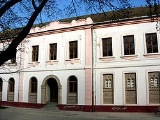
Prigrevica
Encyclopedia
Prigrevica is a village located in the Apatin
municipality, in the West Bačka District
of Serbia
. It is situated in the Autonomous Province of Vojvodina
. The village is located 9 km east from Apatin. Population of Prigrevica counts about 4,781 people (2002 census), mostly ethnic Serbs
.
In German it is known as Batschsentiwan or Sankt Johann an der Schanze (1763). Saint John the Baptist is considered the patron of the village. Its Serbian names were Sentivanprogrevica (recorded in 1772), and Prigrevica Sveti Ivan (recorded in 1893). In 1947, the name was changed to shorter form Prigrevica.
When the Yugoslav Partisans came on October 24, 1944, they liberated Prigrevica from Axis occupation. The antifascist council for deliberation of Yugoslavia (AVNOJ) declared its mainly German population as public enemies. Also in Prigrevica the German civil population became victim of excessive revenge of the partisans. They were partially shot, tortured to death or sent to one of several concentration camps that existed until 1948.
After the Second World War, Prigrevica was settled by colonists who mostly originated from Lika
and Banija
.
Apatin
Apatin is a town and municipality in the Vojvodina administrative region of Serbia, located in the West Bačka District, at . The town of Apatin is the administrative, economic, cultural, educational and tourist centre of the municipality of Apatin...
municipality, in the West Bačka District
West Backa District
West Bačka District is a northern district of Serbia. It lies in the region of Bačka, in the autonomous province of Vojvodina. It has a population of 215,916...
of Serbia
Serbia
Serbia , officially the Republic of Serbia , is a landlocked country located at the crossroads of Central and Southeast Europe, covering the southern part of the Carpathian basin and the central part of the Balkans...
. It is situated in the Autonomous Province of Vojvodina
Vojvodina
Vojvodina, officially called Autonomous Province of Vojvodina is an autonomous province of Serbia. Its capital and largest city is Novi Sad...
. The village is located 9 km east from Apatin. Population of Prigrevica counts about 4,781 people (2002 census), mostly ethnic Serbs
Serbs
The Serbs are a South Slavic ethnic group of the Balkans and southern Central Europe. Serbs are located mainly in Serbia, Montenegro and Bosnia and Herzegovina, and form a sizable minority in Croatia, the Republic of Macedonia and Slovenia. Likewise, Serbs are an officially recognized minority in...
.
Name
The village was founded about 600 years ago and it was recorded as Zenthyvan.In German it is known as Batschsentiwan or Sankt Johann an der Schanze (1763). Saint John the Baptist is considered the patron of the village. Its Serbian names were Sentivanprogrevica (recorded in 1772), and Prigrevica Sveti Ivan (recorded in 1893). In 1947, the name was changed to shorter form Prigrevica.
History
In the end of the 17th century the village became part of the Habsburg Monarchy. A new wave of colonisation occurred in 1748 when many German colonists settled in Prigrevica. The colonists came from many different regions in southern Germany and East France. The gathering centre was in Ulm, Germany and from that point they were transported by the Danube to Apatin, which became the main base of the German expansion in Vojvodina.When the Yugoslav Partisans came on October 24, 1944, they liberated Prigrevica from Axis occupation. The antifascist council for deliberation of Yugoslavia (AVNOJ) declared its mainly German population as public enemies. Also in Prigrevica the German civil population became victim of excessive revenge of the partisans. They were partially shot, tortured to death or sent to one of several concentration camps that existed until 1948.
After the Second World War, Prigrevica was settled by colonists who mostly originated from Lika
Lika
Lika is a mountainous region in central Croatia, roughly bound by the Velebit mountain from the southwest and the Plješevica mountain from the northeast. On the north-west end Lika is bounded by Ogulin-Plaški basin, and on the south-east by the Malovan pass...
and Banija
Banija
Banovina is a geographical region in central Croatia, between the rivers Sava, Una, and Kupa. Main towns in the region include Petrinja, Glina, Kostajnica, and Dvor. The area is almost entirely located in the Sisak-Moslavina county...
.
Ethnic groups (2002 census)
- SerbsSerbsThe Serbs are a South Slavic ethnic group of the Balkans and southern Central Europe. Serbs are located mainly in Serbia, Montenegro and Bosnia and Herzegovina, and form a sizable minority in Croatia, the Republic of Macedonia and Slovenia. Likewise, Serbs are an officially recognized minority in...
= 4,569 (95.57%) - CroatsCroatsCroats are a South Slavic ethnic group mostly living in Croatia, Bosnia and Herzegovina and nearby countries. There are around 4 million Croats living inside Croatia and up to 4.5 million throughout the rest of the world. Responding to political, social and economic pressure, many Croats have...
= 50 (1.05%) - YugoslavsYugoslavsYugoslavs is a national designation used by a minority of South Slavs across the countries of the former Yugoslavia and in the diaspora...
= 29 (0.61%) - Hungarians = 21 (0.44%)
- others.
Historical population
- 1900: 5,054 Inhabitants, 4812 Germans, 195 Hungarians, 47 others
- 1948: 5,219 Inhabitants, 89,3 % Serbs und 7,4 % Yugoslavians
- 1953: 5,480
- 1961: 5,449
- 1971: 5,033
- 1981: 5,026
- 1991: 4,842
- 2002: 4,781 (almost 100 % Serbs)
Culture
Cultural-artistic society "KUD Prigrevica" was founded in 1996 and it has about 100 members who are active in different sections of the society.Famous people
- Željko RebračaŽeljko RebracaŽeljko Rebrača is a retired Serbian professional basketball player. Formerly in the NBA, he finished his career with the Spanish ACB League team Pamesa Valencia.-Europe:He began his professional career in 1991 with KK Partizan...
, a professional basketball player in the NBA. He was born in Prigrevica in 1972.

